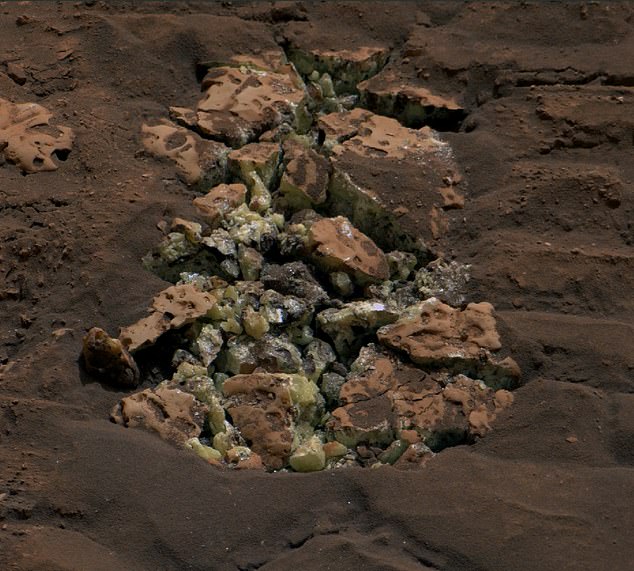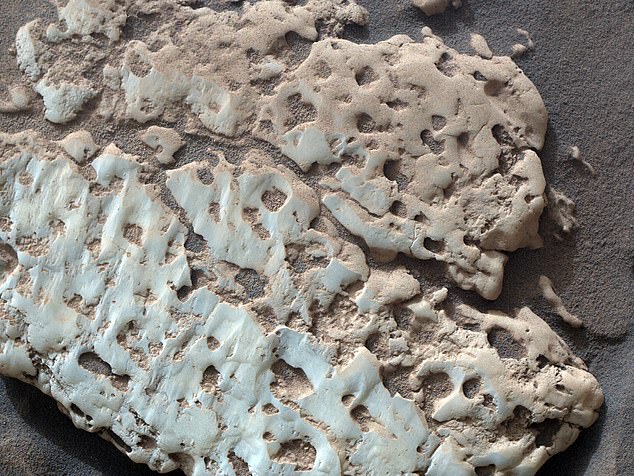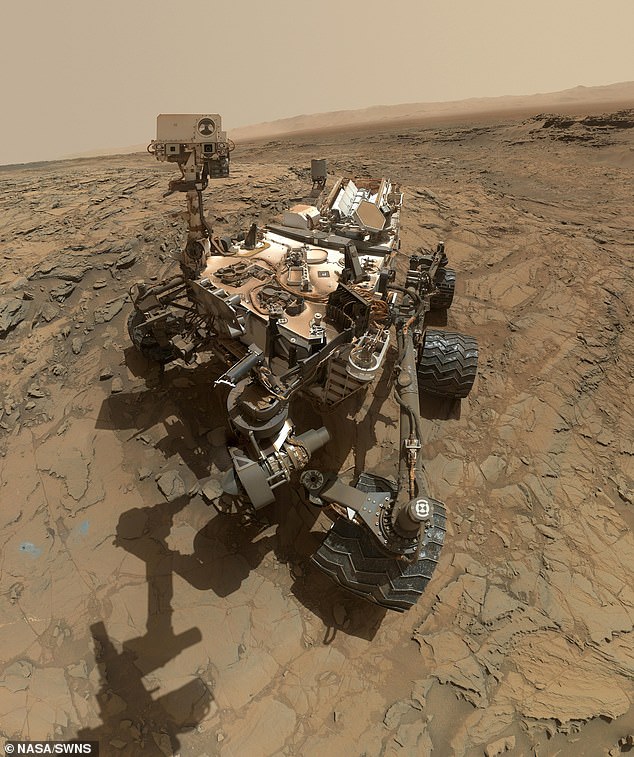NASA’s Curiosity rover has made a “mind-blowing” discovery on Mars that scientists say “shouldn’t have been there.”
The one-ton rover discovered yellow-green crystals of pure sulfur while searching for chemical evidence the Red Planet was once habitable.
Although minerals containing sulfur have been found on Mars, elemental sulfur itself has never been observed before.
Curiosity accidentally cracked open white rocks as it traveled through the Gediz Vallis Channel, revealing the “strange” features that add to the growing evidence that Mars was once a habitable planet.

The one-ton rover discovered yellow-green crystals of pure sulfur during its search for chemical evidence the Red Planet was once habitable
Sulfur is used to make two essential amino acids needed for proteins and is seen as a sign of life on Earth.
But scientists have not said The discovery of Curiosity is a clue to past life on Mars.
The discovery adds to growing evidence that even more life-sustaining elements have been found on Mars, including carbon, hydrogen, nitrogen, oxygen and phosphorus.
What the discovery does show is that there was a lot of water on Mars, which is also an important ingredient for life.
Ashwin Vasavada, Curiosity project scientist, said: “Finding a field full of rocks made of pure sulfur is like finding an oasis in the desert.
“It shouldn’t be there, so now we have to explain it. Discovering strange and unexpected things is what makes planetary exploration so exciting.”
The groundbreaking discovery was made on May 30, while Curiosity was driving off-road in the Gediz Vallis Channel, a groove that runs along part of the 3-mile-high (5-kilometer) Mount Sharp. The rover has been climbing to the base of the mountain since 2014.
The six-wheeled rover has previously found sulfur on Mars, but only mixed with other minerals, such as magnesium and calcium.
When combined with other elements, sulfur gives off a pungent odor, but the pure sulfur on Mars is odorless.
NASA scientists at the Jet Propulsion Laboratory (JPL) in California first identified a collection of white rocks and commissioned Curiosity to explore them.
The rover sent a close-up photo of the white rocks back to Earth, which also showed an ear of shattered rocks near Curiosity’s wheels.
And then the team discovered the yellow crystals.
“I think it’s the strangest find of the entire mission and the most unexpected,” Vasavada said. CNN.


Curiosity made the strange discovery by accidentally breaking white rocks during its journey through the Gediz Vallis Channel
“I have to say there is a lot of luck involved. Not every stone has something interesting in it.”
Although the sulfur rocks were too small and brittle to be sampled with the drill, a large rock formation nicknamed “Mammoth Lakes” was discovered nearby.
Rover engineers had to locate a section of rock where drilling was safe and find a place to park on the loose, sloping surface.
After Curiosity drilled the 41st hole with the powerful drill on the end of the rover’s six-foot-long robotic arm, the six-wheeled scientist dripped the pulverized rock into instruments on the rover for further analysis, allowing scientists to determine what materials the rock was made of.
“Nobody had pure sulfur on their bingo card,” Vasavada said.
Sulfur rocks typically have a “beautiful, translucent, crystalline texture,” the scientists explain.
But the group we see on Mars has been sandblasted over millions of years, dulling the bright yellow color and making the particles appear reddish, like the surrounding landscape.
However, the discovery adds to growing evidence that other life-sustaining elements have been found on Mars, including carbon, hydrogen, nitrogen, oxygen and phosphorus.
The Gediz Vallis Channel is one of the main reasons the science team wanted to visit this part of Mars. The region is located just south of the Martian equator.
Scientists believe the channel was created by flows of liquid water and debris, creating a two-mile-long strip along the mountainside beneath the channel.
The aim was to gain a better understanding of how this landscape changed billions of years ago. Recent clues have contributed to this.
Since Curiosity arrived at the canal earlier this year, scientists have been investigating whether ancient floods or landslides formed the large piles of debris rising from the bottom of the canal.


The rover sent a close-up of the white rocks back to Earth, with an ear of shattered rocks near Curiosity’s wheels. That’s when the team spotted the yellow crystals
Curiosity’s latest evidence suggests that both factors played a role: Some mounds were likely created by heavy water flows and debris, while others appear to be the result of localized landslides.
These conclusions are based on rocks found in the debris. While rocks carried by the water flow become rounded like river stones, some debris is strewn with more angular rocks that may have been deposited by dry avalanches.
Eventually, water soaked into all the material that had settled here. Chemical reactions caused by the water revealed white “halo” shapes in some of the rocks. Erosion by wind and sand has revealed these halo shapes over time.
“This has not been a quiet time on Mars,” said Becky Williams, a scientist at the Planetary Science Institute in Tucson, Arizona, and deputy principal investigator for Curiosity’s Mast Camera.
“There was an exciting amount of activity here. We’re looking at multiple currents in the channel, including strong flooding and boulder-heavy currents.”



